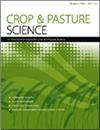Phenotypic variation of Kikuyu grass (Cenchrus clandestinus) across livestock production farms in Colombian highlands is explained by management and environment rather than genetic diversity
IF 1.9
4区 农林科学
Q2 AGRICULTURE, MULTIDISCIPLINARY
引用次数: 0
Abstract
Context Kikuyu grass (Cenchrus clandestinus (Hochst. ex Chiov.) Morrone) is native to the Central African highlands and was introduced to Colombia in 1928 to feed animals. Despite its low genetic diversity and proven genetic clonality, this species has shown broad phenotypic variation and has become the primary forage resource for livestock production systems in the Colombian highlands. However, it is necessary to determine whether genetic diversity should be considered when designing management programs.Aims We aimed to determine which variables among location, altitude and population genetic structure explain the phenotypic variation of Kikuyu grass samples across livestock farms at high altitudes.Methods We used principal component analysis, redundancy analysis and partial redundancy analysis to understand the contribution of three explanatory variables (three high-altitude ranges, six locations and two or five genetic clusters) and 30 covariables (pasture management and soil traits of each farm) to explain 18 phenotypic variables of 146 Kikuyu grass samples from high-altitude livestock farms in Colombia.Key results All explanatory variables and covariables explained 39.1–41.5% of the phenotypic variation of Kikuyu grass in Colombia. However, the effect of the genetic structure based on two or five clusters was negligible. By comparison, locality, altitude and 13 covariables of productive system management and soil traits were significant.Conclusions Genetic population structure was insignificant in explaining the phenotypic variation of Kikuyu grass in Colombia.Implications Future research on Kikuyu grass in Colombia should focus on farm management variables and soil trait analyses.哥伦比亚高地牲畜生产农场的基库尤草(Cenchrus classentus)表型变异是由管理和环境而不是遗传多样性解释的
基库尤草(Cenchrus claindestus);Chiov交货)。莫罗内(Morrone)原产于中非高地,1928年被引入哥伦比亚喂养动物。尽管其遗传多样性和已证实的遗传克隆性较低,但该物种已显示出广泛的表型变异,并已成为哥伦比亚高地牲畜生产系统的主要饲料资源。然而,有必要确定在设计管理方案时是否应考虑遗传多样性。目的探讨地理位置、海拔高度和种群遗传结构中哪些变量可以解释高海拔地区畜牧场基库尤草样品的表型差异。方法利用主成分分析、冗余分析和部分冗余分析,了解3个解释变量(3个高海拔范围、6个地点和2个或5个遗传集群)和30个协变量(每个农场的牧场管理和土壤性状)对哥伦比亚高海拔牲畜养殖场146份基库尤草样品18个表型变量的解释贡献。所有解释变量和协变量解释了哥伦比亚基库尤草表型变异的39.1% ~ 41.5%。然而,基于两个或五个簇的遗传结构的影响可以忽略不计。通过比较,产地、海拔和生产系统管理与土壤性状的13个协变量显著。结论遗传群体结构对哥伦比亚基库尤草的表型变异解释不显著。未来对哥伦比亚基库尤草的研究应侧重于农场管理变量和土壤性状分析。
本文章由计算机程序翻译,如有差异,请以英文原文为准。
求助全文
约1分钟内获得全文
求助全文
来源期刊

Crop & Pasture Science
AGRICULTURE, MULTIDISCIPLINARY-
CiteScore
4.20
自引率
15.80%
发文量
111
审稿时长
3 months
期刊介绍:
Crop and Pasture Science (formerly known as Australian Journal of Agricultural Research) is an international journal publishing outcomes of strategic research in crop and pasture sciences and the sustainability of farming systems. The primary focus is broad-scale cereals, grain legumes, oilseeds and pastures. Articles are encouraged that advance understanding in plant-based agricultural systems through the use of well-defined and original aims designed to test a hypothesis, innovative and rigorous experimental design, and strong interpretation. The journal embraces experimental approaches from molecular level to whole systems, and the research must present novel findings and progress the science of agriculture.
Crop and Pasture Science is read by agricultural scientists and plant biologists, industry, administrators, policy-makers, and others with an interest in the challenges and opportunities facing world agricultural production.
Crop and Pasture Science is published with the endorsement of the Commonwealth Scientific and Industrial Research Organisation (CSIRO) and the Australian Academy of Science.
 求助内容:
求助内容: 应助结果提醒方式:
应助结果提醒方式:


